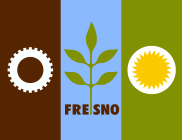Fresno Yosemite International Airport
| Fresno Yosemite International Airport | |||||||||||||||
|---|---|---|---|---|---|---|---|---|---|---|---|---|---|---|---|
|
| |||||||||||||||
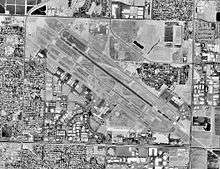 USGS aerial image, 1998 | |||||||||||||||
| Summary | |||||||||||||||
| Airport type | Public / Military | ||||||||||||||
| Owner | City of Fresno | ||||||||||||||
| Operator | City of Fresno Airports Division | ||||||||||||||
| Serves | Fresno, California | ||||||||||||||
| Elevation AMSL | 336 ft / 102 m | ||||||||||||||
| Coordinates | 36°46′36″N 119°43′08″W / 36.77667°N 119.71889°WCoordinates: 36°46′36″N 119°43′08″W / 36.77667°N 119.71889°W | ||||||||||||||
| Website |
flyfresno | ||||||||||||||
| Maps | |||||||||||||||
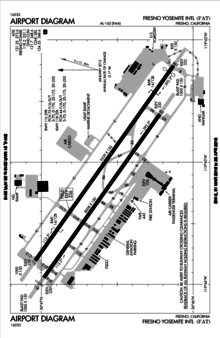 Runway diagram | |||||||||||||||
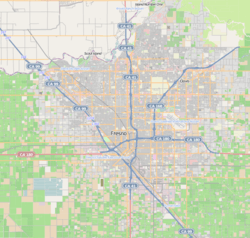 FAT  FAT  FAT | |||||||||||||||
| Runways | |||||||||||||||
| |||||||||||||||
| Statistics (2017) | |||||||||||||||
| |||||||||||||||
Fresno Yosemite International Airport (IATA: FAT, ICAO: KFAT, FAA LID: FAT), is a joint civil-military airport in Fresno, California. It is the primary commercial airport for the San Joaquin Valley and three national parks: Yosemite, Sequoia and Kings Canyon. It offers scheduled passenger flights to several major airline hubs in the United States and international service to Mexico. The airport is owned and operated by the city of Fresno and has two runways on a property spanning 1,728 acres (699 ha). Its airport code 'FAT' stands for "Fresno Air Terminal," a former name for the airport.
The facility opened in June 1942 as Hammer Field, a military airfield. Due to its central location within the state, the airport is home to several military, law enforcement, firefighting, and medical air units. The Fresno Air National Guard Base on the southeast corner of the airport is home to the 144th Fighter Wing of the California Air National Guard. The Fresno Air Attack Base on the eastern side of the airport supports aerial firefighting aircraft. Other government and military operators with facilities at the airport include the California Army National Guard, the California Highway Patrol, the Fresno County Sheriff's Office, and the Fresno Police Department.
Fresno is home to a large operations base for SkyWest Airlines, the nation's largest regional airline.
History
The Fresno Yosemite International Airport opened as a military airfield in June 1942, just six months after Japan's attack on Pearl Harbor, leading the United States to enter World War II. The new airfield was named Hammer Field and was used by the United States Army Air Forces as a training facility for the new pilots of the Fourth Air Force. It had a single northwest/southeast oriented runway with a length of 7,200 feet (now runway 11L/29R).[3]
At the time, civil and commercial aviation used Chandler Field that had opened in November 1929.[4] Chandler is located just 1.5 miles (2.4 km) west of downtown Fresno, but is on a relatively small site. Less than a decade after it was opened, it was already clear that the small runway at Chandler would not be able to accommodate the increasingly larger airplanes used by the commercial airlines.[4]
After World War II, Hammer Field was inactivated by the Army Air Forces and the city of Fresno saw an opportunity to use the site to create a commercial airport much larger than Chandler Field. In 1946 the War Assets Administration reallocated the property to the city, which immediately began construction on a passenger terminal on the northeast side of the airfield. In 1948, the newly renamed Fresno Air Terminal (FAT) opened. Trans World Airlines (TWA) and United Airlines flights to San Francisco/Oakland and Los Angeles moved from Chandler Field to the newly opened airport. Chandler Field was retained by the city of Fresno as a reliever airport and continues to operate as the Fresno Chandler Executive Airport.[3][4]
The California Air National Guard moved to the airport in the 1950s and established the Fresno Air National Guard Base on the southeast corner of the property. The guard also built munition storage bunkers along the northern edge of the airport grounds.[5] The 194th Fighter Squadron moved to the facility in late 1954, followed by the 144th Fighter Wing in 1957.[6] As the guard moved in, a second parallel runway (11R/29L) was constructed and opened to traffic in 1956.[3]
A new, larger passenger terminal started to come together in 1959 along the southern portion of the airport.[3] The main building comprised three areas: a baggage claim area, the central lobby, and the ticketing area. Although significantly renovated, that building still stands today and still serves the same functions. From the central lobby, passengers used an underground tunnel to reach the open-air, remote concourse where they boarded planes from ground level boarding gates.[3]
The current air traffic control tower was also constructed around the same time as the passenger terminal and opened shortly after in 1961.[3]
The jet age arrived in Fresno in 1967 when Pacific Air Lines became the first airline to schedule jet service to the airport. The carrier used the Boeing 727-100 to operate nonstop service to both Los Angeles and San Francisco.[7]
The first significant expansion to the passenger terminal came in 1978 when a concourse was built straight out from the central lobby. This building, unlike the original remote concourse, was both enclosed and climate controlled.[3]
In the 1970s and 1980s, service to Fresno was split evenly between major air carriers using mainline jets, primarily the Boeing 727, Boeing 737 and Douglas DC-8 and regional airlines using smaller aircraft.[8] Most service was operated to major airline hubs in the Western United States or other airports in California.[8]
In the 1990s, reflecting a national trend, there was a shift to smaller regional jet and turboprop aircraft operated by regional airlines on behalf of mainline air carriers; however, some mainline jet service continued to operate to Fresno.[8]
Fresno has been the headquarters for at least three airlines in its history. In the mid-1980s, Far West Airlines was founded in Fresno and used the airport as a small intrastate hub serving Burbank, Los Angeles, Modesto, Oakland, Orange County, Sacramento and San Jose.[9] Air 21 was founded in Fresno in January 1994 and operated service between several western cities before ceasing operations in January 1997.[10] Allegiant Air was founded in Fresno in January 1997, and its headquarters were located in the city until it declared bankruptcy in 2000, and the new CEO moved its headquarters to a suburb of Las Vegas.
In 1996, the airport's name was changed from Fresno Air Terminal to Fresno Yosemite International Airport to attract out-of-state and international visitors to Yosemite National Park to the airport. Despite the new name, scheduled international commercial flights would not begin operating in Fresno for nearly a decade.[11] At the time, airport managers petitioned the FAA for a new identifier code to replace FAT, which carries a negative connotation and no longer matched the initials of the airport. The request was denied, with the FAA reaffirming its long-standing policy to only issue a new identifier code when an airport is physically relocated (such as in 1995 when Denver Airport was moved out of Stapleton).[12]
Expansion and remodeling
At the turn of the 21st century, the city began a series of projects that would expand and remodel the passenger terminal. The first and most notable project was the expansion of the concourse building. The project, designed by DMJM Aviation extended the terminal further northeast and created a new two-level section with six jetbridges. Before this project passengers boarded all planes using stairs or ramps. When completed in 2002, the new concourse building received praise for its design and was named one of the top 10 projects in Fresno Architecture for the decade with critics commending the use of steel and the curved glass facade.[13]
A new Federal Inspection Services facility for international arrivals was completed in early 2006, giving federal officials space to check passports and complete customs work. Completion of that facility allowed Fresno to begin receiving scheduled international commercial flights. The first international service started in April 2006 with Mexicana operating flights between Fresno and Mexico City with an intermediate stop in Guadalajara.[11]
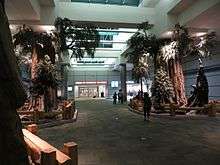
With the new concourse extension and new international arrivals facility completed, older portions of the terminal building were given a major renovation. The project was designed CSHQA and completed in several phases between 2006 and 2010. While keeping the facility operational, nearly every part of the building was updated including the baggage claim area, security checkpoint, central lobby, ticketing area, and low-level concourse. The centerpiece of the project was the construction of a life-size, replica sequoia forest in central lobby, reflecting the airport's role as a gateway to the nearby national parks. The giant trees appear to be supporting the roof of the terminal and are surrounded by the split rail fencing and granite curbs that visitors see at national parks.[14][15][16]
A consolidated rental car facility opened at the airport in 2009. The $22 million project allows customers of most rental car companies to pick up and drop-off vehicles just outside the terminal. The project also included the construction of maintenance buildings and storage lots on a nearby, 11-acre site.[17]
Direct international service from Fresno briefly ended in August 2010 when Mexicana ceased operations. International service resumed, with more flights, less than a year later when both Aeroméxico and Volaris added service between Fresno and Guadalajara in April 2011.[18][19]
The secondary runway (11R/29L) was widened, lengthened and strengthened in a $30 million project completed in October 2012.[20]
Airline service
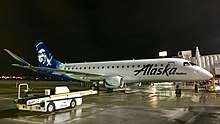
The majority of scheduled commercial flights to Fresno use smaller regional jet aircraft operated by regional airlines, and the airport is home to a significant operations base for SkyWest Airlines, the nation's largest regional airline. Fresno does still see mainline jet service on the busiest routes, and while only a few international flights operate to Mexico each day, they are some of the airport's most well patronized.[21]
SkyWest carries between 55 and 60 percent of the passenger traffic at Fresno.[2] The regional airline operates under contract with mainline partners as American Eagle, Alaska SkyWest, Delta Connection and United Express. SkyWest has a 17-acre maintenance and overnight parking facility on the east side of the airfield with 21 aircraft positions, and an approximately 92,000 square foot hangar.[3] SkyWest also uses Fresno as a crew base for pilots and flight attendants.[22]
Mainline air carrier service includes Allegiant Air service to Las Vegas operated with the Airbus A320, American Airlines service to Dallas/Fort Worth operated with the Boeing 737-800, United Airlines service to San Francisco with Airbus A320, and Frontier Airlines service to Denver with the Airbus A321.[23][24]
International carriers also use mainline jets on their service to Mexico. Aeroméxico and Volaris both operate service between Fresno and Guadalajara, Mexico's second-largest city and a major airline hub in the country. Additionally, Volaris also operates service to Morelia, the capital of and largest city in Mexico's Michoacán state. Direct international service from Fresno began on April 1, 2006, and are now some of the busiest flights from the airport. As of 2016, international service on Aeroméxico and Volaris accounted for about 6% of all flights to Fresno, but carried more than 13% of all passengers flying to the airport, a combined total of almost 201,000 people.[21]
The longest continuously operating carrier out of the Fresno Yosemite International Airport is United Airlines, which began serving the airport on its opening day. Although, for about two decades, United did not operate directly operate service to Fresno, instead shifting service in the mid-1990s to SkyWest, which operates flights as United Express. United resumed mainline jet service on August 15, 2017, between Fresno and its hub in San Francisco, reflecting the increased traffic on the route.[25] On June 7, 2018, United Airlines launched daily non-stop, long-haul service between Fresno Yosemite International Airport and Chicago's O'Hare International Airport, marking United's commitment to passengers in the Fresno area.[26] The Fresno - Chicago service on United is the longest non-stop route to or from Fresno Yosemite International Airport at 1,730 miles and offers the only non-stop service to the Midwest.
Infrastructure
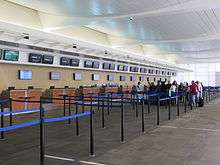
Airfield
Fresno Yosemite International Airport covers 1,728 acres (699 ha) at an elevation of 336 ft (102 m) above mean sea level, with two paved asphalt runways: 11L/29R (primary) and 11R/29L (secondary). Runway 11L/29R is 9,539 by 150 ft (2,907 by 46 m) and runway 11R/29L is 8,008 by 150 ft (2,441 by 46 m).[1]
Aircraft
For the year ending March 31, 2017, the airport had 99,559 aircraft operations, an average of 273 per day: 61% general aviation, 18% scheduled commercial, 15% air taxi and 6% military. At that time there were 179 aircraft based at the airport: 56% single-engine, 14% multi-engine, 13% military, 9% jet and 7% helicopter.[1]
Airlines and destinations
Passenger
(Red) = Year-round Destination
(Green) = Seasonal Destination
Cargo
| Airlines | Destinations | Refs. |
|---|---|---|
| Ameriflight | Burbank, Santa Maria, Ontario | [34][35] |
| FedEx Express | Denver, Memphis, Oakland, Visalia | [35] |
| UPS Airlines | Ontario Seasonal: Louisville | [36] |
Statistics
Top destinations
| Rank | City | Passengers | Carriers |
|---|---|---|---|
| 1 | Phoenix, Arizona | 103,000 | American |
| 2 | Los Angeles, California | 103,000 | American, United |
| 3 | Dallas/Fort Worth, Texas | 99,000 | American |
| 4 | San Francisco, California | 80,000 | United |
| 5 | Denver, Colorado | 63,000 | Frontier, United |
| 6 | Las Vegas, Nevada | 60,000 | Allegiant |
| 7 | Seattle–Tacoma, Washington | 56,000 | Alaska |
| 8 | Salt Lake City, Utah | 51,000 | Delta |
| 9 | San Diego, California | 46,000 | Alaska |
| 10 | Portland, Oregon | 24,000 | Alaska |
Airline market share
| Rank | Airline | Passengers | Share |
|---|---|---|---|
| 1 | SkyWest Airlines | 723,000 | 55.29% |
| 2 | American Airlines | 210,000 | 16.05% |
| 3 | Mesa Airlines | 143,000 | 10.95% |
| 4 | Allegiant Air | 116,000 | 8.87% |
| 5 | Compass Airlines | 47,660 | 3.65% |
| — | All others | 67,790 | 5.19% |
Military and government operations
The 144th Fighter Wing of the California Air National Guard is based out of the Fresno Yosemite International Airport.[38] The California Army National Guard also maintains an Aviation Classification Repair Activity Depot (AVCRAD) at the airport.[3] The depot performs high-level maintenance and repair of Army aircraft. Its jurisdiction covers a 15-state region in the Western United States.[39]
Both the U.S. Forest Service and the California Department of Forestry operate an Air Attack Base at the airport for fighting forest fires with aerial tankers.[40]
Other government and military operators with facilities at the airport include the California Army National Guard, the California Highway Patrol, the Fresno County Sheriff's Office, and the Fresno Police Department.
Ground transportation and access
Highways
The airport is located about a mile away from California State Route 180, with vehicles using Peach Avenue to connect between the airport and the highway.[41] California State Route 180 connects to all of the other freeways in the Fresno area: California State Route 41, California State Route 99, and California State Route 168.[42] Yosemite National Park can be accessed by California State Route 41 and Sequoia National Park and Kings Canyon National Park can be accessed by California State Route 180.[43][44]
Parking
The city of Fresno offers paid on-site parking in a large lot located just west of the airport. The lot is divided into a short-term area with 283 stalls and a long-term area with 1,879 stalls. There is also a separate cell phone waiting lot located off the airport's main driveway with 47 stalls, designated for drivers waiting for arriving passengers.[45]
Public transportation
Fresno Area Express (FAX) operates two public transit buses to the airport, each with half-hourly service.[46] Route 26 Palm / Butler runs between the airport and North Fresno via Southeast and Downtown Fresno (where passengers may transfer to other FAX routes). Route 39 FYI/Clinton runs between the airport and West Fresno.
The City of Visalia operates the V-Line bus between the airport and the Visalia Transit Center (where passengers can connect to Visalia Transit routes) and the Visalia Airport (which offers V-Line passengers free long-term parking for up to ten days).[47][48]
Rental car facility
The airport offers a consolidated rental car facility at the north end of the terminal. Nine rental car companies have passenger service counters inside the terminal near the baggage claim area and up to 400 cars can be parked in a lot just north of the terminal building.[17] The 11-acre rental car facility opened in 2009 and was built at a cost of US $22 million.[17]
Accidents and incidents
- On December 14, 1994, a private jet on a military training mission, attempting to land at Fresno, crashed on a Fresno street and skidded into an apartment complex, killing both pilots and injuring 21 people on the ground.[49] The Learjet 35A, piloted by two civilians and belonging to a Georgia-based company, Phoenix Air Group, was contracted by the US Air Force to provide training for Air National Guard pilots. The plane had been involved in a war game with a F-16 fighter jet and was on its way back to the Fresno airport when the flight crew declared an emergency due to engine fire indications. They directed the plane toward their requested runway but the aircraft continued past the airport. On radio transmissions, the flight crew was heard attempting to diagnose the emergency conditions and control the aircraft, until the plane crashed with its landing gear down about 2 miles (3.2 km) southwest of the airport. It then plowed into two buildings in an apartment complex and exploded in a fireball. 12 apartment units in two buildings were destroyed or substantially damaged by impact and fire. The National Transportation Safety Board determined that the probable causes of the accident were: improperly installed electrical wiring that led to an in-flight fire which damaged the aircraft's systems causing a loss of control and improper maintenance and inspection of the aircraft.[50]
- On September 13, 2015, an MD-87 of Aero Air LLC had an engine failure after taking off from Fresno Yosemite International Airport. Pieces of the engine struck a car, damaging it. The aircraft was able to return to the airport safely.[51]
References
- 1 2 3 FAA Airport Master Record for FAT (Form 5010 PDF). Federal Aviation Administration. effective December 7, 2017.
- 1 2 3 "RITA | BTS | Transtats: Fresno, CA: Fresno Yosemite International (FAT)". Bureau of Transportation Statistics. Retrieved September 29, 2018.
- 1 2 3 4 5 6 7 8 9 Fresno Airports Master Plan - Working Paper #2: Inventory (PDF). Kimley-Horn. May 2017. Retrieved November 2, 2017.
- 1 2 3 "Fresno Chandler Executive Airport Website". www.flyfresno.com. Retrieved November 2, 2017.
- ↑ "Inside the 144th FW". 144th Fighter Wing, California Air National Guard. 2010. Retrieved December 23, 2010.
- ↑ "History of the 144th". Air National Guard - 144th Fighter Wing. February 4, 2013. Retrieved November 2, 2017.
- ↑ "Pacific Air Lines Timetable". Pacific Air Lines. April 30, 1967. Retrieved March 13, 2018.
- 1 2 3 "Official Airline Guide – Historic Flight Schedules". www.departedflights.com. Retrieved December 17, 2017.
- ↑ http://www.departedflights.com, Sept. 17, 1984 route map
- ↑ "Air 21 Mar. 4, 1996 system timetable and route map". Departedflights.com.
- 1 2 "Mexicana Airlines Introduces First International Service between Mexico and Fresno". March 27, 2006. Retrieved December 16, 2017.
- ↑ Fresno Yosemite International (2010). "Frequently Asked Questions". City of Fresno. Archived from the original on March 20, 2011. Retrieved December 23, 2010.
- ↑ "Decade in Review: Top 10 in Fresno Architecture". archop. December 31, 2009. Archived from the original on February 26, 2013. Retrieved May 1, 2013.
- ↑ "Sequoia Trees Create Unique Sense of Place at Fresno Yosemite International Airport" (PDF). CSHQA. July 27, 2009. Retrieved December 16, 2017.
- ↑ "Fresno Yosemite International Airport Terminal Renovation". CSHQA. Retrieved December 16, 2017.
- ↑ "Fresno Yosemite Int'l Airport - Roebbelen Contracting, Inc". www.roebbelen.com.
- 1 2 3 "Rental Car Facility (ConRAC) at Fresno-Yosemite International Airport (FAT)". PGAL. March 8, 2016. Retrieved September 25, 2017.
- ↑ "Volaris to Start Flying from FYI to Mexico". WorldNow / KMPH. March 1, 2011. Archived from the original on March 7, 2012. Retrieved March 4, 2011.
- ↑ Sheehan, Tim (March 10, 2011). "Aeroméxico to start Fresno flights April 4". The Fresno Bee. Archived from the original on March 11, 2011. Retrieved March 10, 2011.
- ↑ "Airports $35 Million Improvements Award Provide Economic Boost to Valley" (Press release). Fresno Yosemite International Airport. September 29, 2011. Archived from the original on March 15, 2013. Retrieved June 29, 2012.
- 1 2 3 Sheehan, Tim (October 25, 2017). "Volaris adds second Mexico flight destination from Fresno airport". The Fresno Bee. Retrieved March 13, 2018.
In 2016, Volaris and Aeromexico accounted for about 6 percent of all arriving and departing flights at Fresno Yosemite International airport, but their combined passenger totals of almost 201,000 represented more than 13 percent of all passengers flying to and from Fresno last year.
- ↑ "Fact Sheet" (PDF). SkyWest Airlines. April 2018. Retrieved April 16, 2018.
- ↑ Rodriguez, Robert (July 18, 2017). "This time's the charm? Frontier Airlines returning to Fresno". The Fresno Bee. Retrieved December 17, 2017.
- 1 2 "Route Map". Frontier Airlines. Retrieved April 12, 2018.
- ↑ Sheehan, Tim (May 8, 2017). "United to add flight, seats to Fresno-San Francisco service". The Fresno Bee. Retrieved December 17, 2017.
- ↑ "City of Fresno announces major new route for FYI".
- 1 2 "Worldwide Timetable" (PDF). Delta Air Lines. April 1, 2018. p. 423. Retrieved April 12, 2018.
- ↑ "Flight Timetable". Alaska Airlines. April 1, 2018. pp. 140–141. Retrieved April 12, 2018.
- ↑ "Route Map". Allegiant Air. Retrieved April 12, 2018.
- ↑ "Route Map". American Airlines. April 12, 2018. Retrieved April 12, 2018.
- ↑ "Route Map". United Airlines. Retrieved April 12, 2018.
- ↑ Sheehan, Tim (November 20, 2017). "Chicago will be new airline connection for Fresno travelers". The Fresno Bee. Retrieved November 20, 2017.
- ↑ "Our Destinations". Volaris. Retrieved April 12, 2018.
- ↑ "Fleet & Bases". Ameriflight. Retrieved April 12, 2018.
- 1 2 "Flight Finder". FlightAware. Retrieved April 12, 2018.
- ↑ "The Independent Pilots Association". inside.ipapilot.org. Retrieved February 17, 2018.
- ↑ "RITA | BTS | Transtats: Fresno, CA: Fresno Yosemite International (FAT)". Bureau of Transportation Statistics. Retrieved May 31, 2018.
- ↑ "Fresno Air National Guard Base". Global Security. 2005. Retrieved March 5, 2011.
- ↑ Van Dyke, Col. Mark (August 24, 2015). "1106th TASMG Overview Presentation" (PDF). National Commission on the Future of the Army. Retrieved March 13, 2018.
- ↑ "Fresno Air Attack Base factsheet" (PDF). California Department of Forestry. January 2005. Retrieved March 13, 2018.
- ↑ Hostetter, George (December 23, 2014). "Fresno's Peach Avenue gets long-sought widening". The Fresno Bee. Retrieved April 16, 2018.
- ↑ "State Route 180". California Highways. Retrieved April 16, 2018.
- ↑ "Driving Directions - Yosemite National Park". National Park Service.
- ↑ "Driving Directions - Sequoia & Kings Canyon National Parks". National Park Service.
- ↑ "Parking map". Fresno Yosemite International Airport. Retrieved September 25, 2017.
- ↑ "Department of Transportation | FAX Routes & Schedules". www.fresno.gov. Retrieved September 25, 2017.
- ↑ "Visalia Transit rolls out V-Line service". Visalia Times-Delta. November 17, 2015. Retrieved September 25, 2017.
- ↑ "V-LINE | Your connection to Fresno from Visalia". ridevline.com. Archived from the original on 2016-01-13. Retrieved September 25, 2017.
- ↑ Arax, Mark (December 15, 1994). "At Least 3 Killed as Plane Crashes on Fresno Street : Accident: Learjet has engine trouble while returning to airport. It slams into apartment complex, creating grim scene of destruction". Los Angeles Times. ISSN 0458-3035. Retrieved December 27, 2017.
- ↑ Hall, James E.; Francis II, Robert T.; Hammerschmidt, John (August 1, 1995). Aircraft Accident Report: Crash During Emergency Landing, Phoenix Air, Learjet 35A, N521PA. Fresno, California, December 14, 1994 (PDF) (Report). National Transportation Safety Board. PB95-910404. Retrieved December 27, 2017.
- ↑ "Report that pieces of metal fell from Erickson MD-87 air tanker over Fresno, California". Fire Aviation.
External links
![]()
- Fresno Yosemite International Airport, official web site
- FAA Airport Diagram (PDF), effective October 11, 2018
- FAA Terminal Procedures for FAT, effective October 11, 2018
- Resources for this airport:
- AirNav airport information for KFAT
- ASN accident history for FAT
- FlightAware airport information and live flight tracker
- NOAA/NWS latest weather observations
- SkyVector aeronautical chart for KFAT
- FAA current FAT delay information
